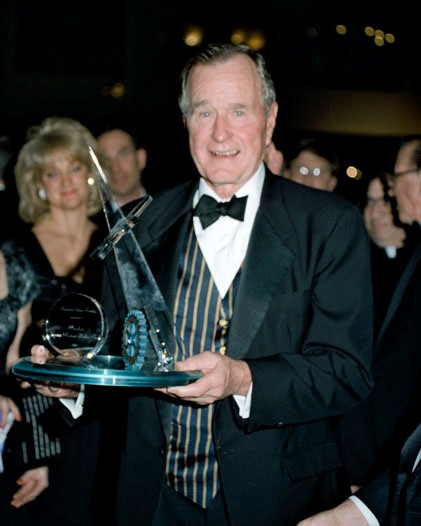1998 NATIONAL SPACE TROPHY RECIPIENT
President George H.W. Bush

George H. W. Bush
Profile by Marianne J. Dyson, as published in the RNASA Program Book, March 6, 1998
George Bush was elected President of the United States of America on November 8, 1988 and was sworn in on January 20, 1989. He served until January 20, 1993. During his term in office, freedom prevailed in the Cold War; the threat of nuclear war was drastically reduced; the Soviet Union was replaced by a democratic Russia; the Berlin Wall fell; and an unprecedented international coalition force liberated Kuwait from Iraq. And in the midst of these historic achievements, President Bush also exhibited tremendous leadership in providing our nation with the vision and means to accomplish our goals in space for the 21st century.
In his report to Congress in January 1989, President Bush described the status and outlook for space activities during his administration. "In 1988 we were proud to return to successful spaceflight with the launch of two space shuttle flights and the additional successful launch of six unpiloted expendable launch vehicles, putting in orbit a wide variety of space tracking, science, navigational, weather, and defense satellites. . . . Our mission to provide leadership in critical areas of space activities in an increasingly competitive international environment urges us to build on the great achievements of those who have gone before and continue with the extraordinary aeronautical and space achievements that this nation has so capably demonstrated."
And build on those accomplishments we did. During President Bush's administration, the United States entered into a new "golden era" of space science as NASA sent the Magellan spacecraft to map Venus, Galileo to Jupiter, and the Cosmic Background Explorer (COBE) to study the origins of the universe. The knowledge gained from these missions continues to challenge our old ideas and excite us with unexpected discoveries.
The President announced on July 20, 1989, the twentieth anniversary of the Apollo 11 landing, the goal of the United States to establish a permanent human presence on the Moon and to use that experience to begin human exploration of Mars. "In 1961, it took a crisis -- the space race -- to speed things up. Today we don't have a crisis; we have an opportunity. To seize this opportunity, I'm not proposing a ten-year plan like Apollo; I'm proposing a long-range continuing commitment. First, for the coming decade, for the 1990's: Space Station Freedom, our critical next step in all our space endeavors. And next, for the new century: Back to the Moon; back to the future. And this time, to stay. And then a journey into tomorrow, a journey to another planet: a manned mission to Mars."
The following year, President Bush announced a specific goal to land humans on Mars no later than 2019. NASA responded by creating the Space Exploration Initiative, a blue print for the path to Mars. President Bush stated, "The challenges of the Space Exploration Initiative are great, but so is the quality of American talent and ingenuity, and so is the leadership of the American people. And . . . it is America's destiny to lead."
President Bush's administration not only launched a new era in human and robotic exploration of our solar system and the universe, it also forged a new partnership with that other great space faring nation, Russia. In 1991, the U. S. and the then Soviet Union agreed to exchange flights by astronauts and cosmonauts on Mir and the Space Shuttle, setting the stage for today's partnership with Russia on the International Space Station Program. This year we will realize President Bush's vision where, together with Russia, Japan, Canada, Brazil, and ten European nations, we begin assembly of the single largest international aerospace project in history.
President Bush's career in politics and public service began in 1963, when he was elected Chairman of the Harris County Texas Republican Party. After losing a bid for the United States Senate in 1964, he was elected in 1966 to the U. S. House of Representatives from Texas' 7th District and served two terms. Following a second unsuccessful campaign for the Senate, Mr. Bush was appointed to a series of senior level positions: U.S. Ambassador to the United Nations (1971); Chairman of the Republican National Committee (1973); Chief of the U.S. Liaison Office in China (1974); and Director of Central Intelligence (1976). In 1980, Mr. Bush campaigned for the Republican nomination for President. He lost, but was chosen as a running mate by Ronald Reagan. He served as Vice President from 1981 to 1989.
The youngest pilot in the Navy when he received his wings, Mr. Bush flew 58 combat missions during World War II. On one mission over the Pacific as a torpedo bomber pilot, George Bush was shot down by Japanese antiaircraft fire and was rescued from the water by a U.S. submarine. He was awarded the Distinguished Flying Cross for bravery in action. After the war, he attended Yale University and graduated Phi Beta Kappa in 1948 with a degree in economics. In 1945, he married Barbara Pierce and moved to Texas where he began making his way in the oil business.
President and Mrs. Bush have five children and fourteen grandchildren. They have been married 52 years and reside in Houston, Texas and Kennebunkport, Maine.
The RNASA Foundation salutes President Bush for his pioneering leadership of our nation's space program. As he said in a speech at the Marshall Space Flight Center in Huntsville in 1990, "History tells us what happens to nations that forget how to dream. The American people want us in space. So, let us continue the dream for our students, for ourselves, and for all humankind."
